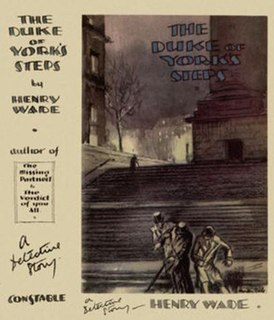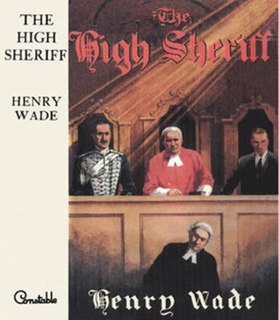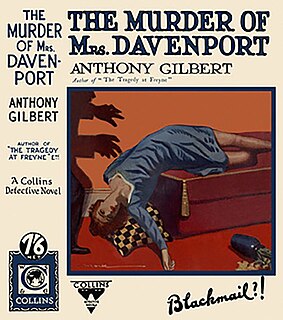
Detective fiction is a subgenre of crime fiction and mystery fiction in which an investigator or a detective—either professional, amateur or retired—investigates a crime, often murder. The detective genre began around the same time as speculative fiction and other genre fiction in the mid-nineteenth century and has remained extremely popular, particularly in novels. Some of the most famous heroes of detective fiction include C. Auguste Dupin, Sherlock Holmes, and Hercule Poirot. Juvenile stories featuring The Hardy Boys, Nancy Drew, and The Boxcar Children have also remained in print for several decades.

A whodunit or whodunnit is a complex, plot-driven variety of a detective story in which the puzzle regarding who committed the crime is the main focus. The reader or viewer is provided with the clues from which the identity of the perpetrator may be deduced before the story provides the revelation itself at its climax. The investigation is usually conducted by an eccentric, amateur, or semi-professional detective. This narrative development has been seen as a form of comedy in which order is restored to a threatened social calm.

Crime fiction, detective story, murder mystery, mystery novel, and police novel are terms used to describe narratives that centre on criminal acts and especially on the investigation, either by an amateur or a professional detective, of a serious crime, generally a murder. It is usually distinguished from mainstream fiction and other genres such as historical fiction or science fiction, but the boundaries are indistinct. Crime fiction has multiple subgenres, including detective fiction, courtroom drama, hard-boiled fiction, and legal thrillers. Most crime drama focuses on crime investigation and does not feature the courtroom. Suspense and mystery are key elements that are nearly ubiquitous to the genre.

John Dickson Carr was an American author of detective stories, who also published using the pseudonyms Carter Dickson, Carr Dickson, and Roger Fairbairn.
The "locked-room" or "impossible crime" mystery is a type of crime seen in crime and detective fiction. The crime in question, typically murder, is committed in circumstances under which it was seemingly impossible for the perpetrator to commit the crime or evade detection in the course of getting in and out of the crime scene. The crime in question typically involves a crime scene with no indication as to how the intruder could have entered or left; for example, a victim found deceased in a windowless room that is sealed from the inside at the time of discovery. Following other conventions of classic detective fiction, the reader is normally presented with the puzzle and all of the clues, and is encouraged to solve the mystery before the solution is revealed in a dramatic climax.

Mystery is a fiction genre where the nature of an event, usually a murder or other crime, remains mysterious until the end of the story. Often within a closed circle of suspects, each suspect is usually provided with a credible motive and a reasonable opportunity for committing the crime. The central character is often a detective, who eventually solves the mystery by logical deduction from facts presented to the reader. Some mystery books are non-fiction. Mystery fiction can be detective stories in which the emphasis is on the puzzle or suspense element and its logical solution such as a whodunit. Mystery fiction can be contrasted with hardboiled detective stories, which focus on action and gritty realism.

The Albany, or simply Albany, is an apartment complex in Piccadilly, London. The three-storey mansion was built in the 1770s and divided into apartments in 1802.
The Golden Age of Detective Fiction was an era of classic murder mystery novels of similar patterns and styles, predominantly in the 1920s and 1930s.
Martha Grimes is an American writer of detective fiction. She is best known for a series featuring Richard Jury, a Scotland Yard inspector.

Hamlet, Revenge! is a 1937 novel by Michael Innes, his second novel. It centers on the investigation into the murder of the Lord Chancellor of England during an amateur production of Shakespeare's Hamlet, in which he plays Polonius, and other crimes which follow at the seat of the Duke of Horton, Scamnum Court.

Tom Brown's Body is a 1949 mystery detective novel by the British writer Gladys Mitchell. It is the twenty second in her long-running series featuring the psychoanalyst and amateur detective Mrs Bradley. The title refers to both the novel Tom Brown's School Days and the song John Brown's Body. Mitchell had previously used a school setting for her earlier work Death at the Opera.

The Duke of York's Steps is a 1929 mystery detective novel by the British writer Henry Wade. It was the first in a series of seven novels featuring the character of Chief Inspector Poole, published during the Golden Age of Detective Fiction. The title refers to the steps that connect the Duke of York Column to The Mall in Central London. It is notable for its portrayal of a German Jewish character, a banker who seeks revenge for his mistreatment by murdering a fellow banker. It was well-received by critics and sold well. In The Observer the reviewer Gerald Gould wrote "It would be difficult to overpraise it".

The High Sheriff is a 1937 mystery detective novel by the British writer Henry Wade. Wade was a writer of the Golden Age of Detective Fiction, best known for his series featuring Inspector Poole. This was one of a number of stand-alone novels he wrote, structured as a partially inverted detective story.

The Bell of Death is a 1939 mystery detective novel by Anthony Gilbert, the pen name of British writer Lucy Beatrice Malleson. It is the sixth in her long-running series featuring the unscrupulous London lawyer and detective Arthur Crook. It was published during the Golden Age of Detective Fiction. Reviewing it for the Times Literary Supplement, Maurice Percy Ashley commented "as usual with Mr. Gilbert’s stories this is exciting and well written, but it is so complicated that the reader can do little more than hold his breath".

The Murder of Mrs. Davenport is a 1928 mystery detective novel by Anthony Gilbert, the pen name of British writer Lucy Beatrice Malleson. It was the second novel featuring her amatuer detective Scott Egerton.

The Mystery of the Open Window is a 1929 mystery detective novel by Anthony Gilbert, the pen name of British writer Lucy Beatrice Malleson. It is the fourth novel in a series featuring her amatuer detective, the politician Scott Egerton. Unlike the rest of the series it was published by Gollancz rather than Collins. It takes the form of a locked room mystery, a popular branch of the genre during the Golden Age of Detective Fiction.
Lynn Brock (1877-1943) was the pseudonym of the Irish writer Alister McAllister, who moved to England and wrote a series of mystery novels. Brock is best known for his series of Colonel Gore detective novels, which enjoyed popularity in the 1920s and 1930s during the Golden Age of Detective Fiction. His novels employ a complexity of style and are generally set in rural locations. He also wrote several plays under the name Anthony Wharton.

The Mendip Mystery is a 1929 mystery detective novel by the Irish-born writer Lynn Brock. It was the fifth of seven novels in his series featuring the character of Colonel Wyckham Gore, one of the most prominent investigators during the early stages of the Golden Age of Detective Fiction. It was published in America with the alternative title of Murder at the Inn.

The Man Who Was Too Clever is a 1935 mystery detective novel by Anthony Gilbert, the pen name of British writer Lucy Beatrice Malleson. It is the tenth and last in a series of novels featuring her amatuer detective and politician Scott Egerton. The following year she introduced a new character, the unscrupulous solicitor Arthur Crook, in Murder by Experts.
Q.E.D. is a 1930 mystery detective novel by the Irish-born writer Lynn Brock. It was the sixth of seven novels in his series featuring the character of Colonel Wyckham Gore, one of the most prominent investigators during the early stages of the Golden Age of Detective Fiction. It was published in the Under States with the alternative title of Murder on the Bridge.














